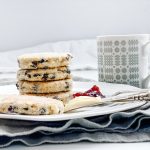
Welsh Cakes
Made from flour, butter, sugar, currants, egg and a dash of milk, they are similar to scones. However, they are cooked on a griddle or bake stone, and out of necessity, are thinner, so that they can be cooked through without burning. Makes 24 - 25
Ingredients
- 250g plain/all-purpose flour
- 2 teaspoons baking powder
- ¾ teaspoon grated nutmeg – or use mixed spice and/or cinnamon (optional)
- ¼ teaspoon fine salt
- 100g unsalted butter, fridge cold and cubed
- 25g lard or vegetable shortening, fridge cold and cubed
- 75g caster sugar
- 1 – 1½ tablespoons milk
- 1 large egg
- 125g currants, or you can use sultanas and/or raisins
- vegetable or groundnut oil or a small knob of butter
- extra caster or granulated sugar to dip the Welsh cakes into when cooked
Instructions
-
Collect together your equipment (see Recipe Notes below) and ingredients.
-
Put the flour, baking powder, spice, (if using) and salt into a food processor. Add the butter and lard and process until you get fine breadcrumbs.
-
Add the sugar and pulse until well mixed.
-
Beat the egg with 1 tablespoon milk, add to the flour mixture and process until the mixture starts to comes together. Add the remaining ½ tablespoon milk, only if necessary.
-
Tip the mixture out of the food processor onto a lightly floured work surface, add the dried fruit to the centre of the ingredients and mix in with your hands as you bring the dough together into a ball.
-
Roll out to approximately 5mm to 7.5mm thick and cut out your Welsh cakes with a cutter. I use a 6cm/2.5in cutter but you can make them smaller or bigger. Re-roll and cut out any leftovers. If the dough feels like it is sticking onto the work surface, release with a palette knife before cutting out.
-
This mixture makes around 24 – 25 Welsh cakes, depending on the size of the cutter you use. They are best eaten fresh, so I cook only what we will eat that day. The remainder, I either freeze or keep covered in the fridge, separating each cake with a small square of baking parchment.
-
To cook: lightly grease the base of a cast iron griddle or baking stone or you can use a heavy frying pan. I use a little (around ½ – 1 teaspoon) oil, which I drizzle on and then wipe around with kitchen paper. You can also use a small knob of butter.
-
Heat the pan on a medium to medium-low heat. When hot, cook just 1 cake to see if the pan is at the correct temperature. I like to cook the cakes on a medium heat initially (later turning it down to medium-low) for roughly 2½ – 3 minutes on each side until lightly browned and cooked through. If you cook them for less, the inside may not be cooked and if you cook them for much longer, they can dry out.
-
If the cakes are cooking too quickly, turn the heat down – your pan will heat up, the more you cook, so keep an eye on it and adjust the heat to ensure you are cooking for 2½ – 3 minutes per side!
-
When cooked, immediately transfer to a plate with caster sugar and cover both sides. Eat as fresh as possible - they are gorgeous whilst still warm - either as they are, or with butter and/or jam.
Recipe Notes
Equipment:
- kitchen scales and measuring spoons
- food processor
- rolling pin
- 6cm/2.5in pastry cutter - or your preferred size
- griddle, bake stone or large heavy frying pan